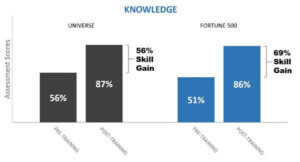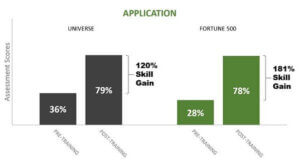How can you know if a sales training program actually delivers on its promise of improvements in skills and knowledge? And how can you know that trained salespeople are actually using their new skills to generate new revenue and other measurable evidence of better performance?
As I have explained in previous editions of eCoach, my company, The Sales Board, has been using a validated instrument to reliably measure factors pertaining to Action Selling ® training since 1995. Those factors include how much knowledge a salesperson has about each of the five Critical Selling Skills that Action Selling ® teaches; how much that knowledge level improves after training; and how well the person is able to use the knowledge on the job.
That last point—measuring the application of skills and knowledge on the job—has always been the missing link in proving a direct connection between sales training and a subsequent increase in sales revenue.
Over the course of two decades and counting, we have compiled data on 400,000 salespeople from more than 3,500 companies in a broad range of industries. Our SQL relational database contains about 78 million data points. We have so much “big data” on the impact of sales training that we can report results not only for the whole “universe” of salespeople, but for salespeople within particular industries.
We also can look at companies in different size categories, regardless of their industries. When we isolate our findings about salespeople in Fortune 500 companies and compare them with the “universe” at large, some curious findings jump out.
In the Fortune 500, salespeople have further to climb.
Our data shows that prior to training, salespeople in the Fortune 500 tend to have less knowledge about sales skills—and to apply less of what they do know—than their counterparts in smaller companies.
That means there is more room for improvement via training in the Fortune 500 than in the universe at large.
If we look at post-training results for all five critical skills combined, Fortune 500 salespeople posted a 53% improvement in Knowledge (vs. 43% for the universe) and a whopping 106% boost in Application (vs. 86% for the universe).
The reason for that is simple: Before training, Fortune 500 reps begin with lower scores. Thus, they have more room to grow.
The trend is illustrated dramatically if we focus on Critical Skill No. 5, Gaining Commitment. This refers to the salesperson’s ability to get a customer to agree to take an action that will move the sales process forward—a “next step” on the path toward a completed sale.
Here is what the training data shows for salespeople in the Fortune 500, vs. the broader universe of companies, when we isolate the skill of Gaining Commitment:
IMPROVEMENT IN CRITICAL SALES SKILL #5: GAINING COMMITMENT


Notice that the pre-training scores for both Knowledge and Application are significantly lower in the Fortune 500 than in the broader universe. Therefore, even though the post-training scores are nearly identical, the skill gain for Fortune 500 salespeople is much greater: 69% in Knowledge (vs. 56%), and >181% in Application(vs. 120%). The Fortune 500 reps simply had farther to go in order to reach the same skill levels.
Why is it that salespeople in big, brand-name companies appear to be less skillful (before training) than others? Our hypothesis is that salespeople in the Fortune 500 tend to get less training than their counterparts because of an assumption that brand recognition, rather than sales skills, can be relied upon to sway customers.
To some degree, that may be true. But the enormous post-training gains in both Knowledge and, especially, Application, suggest that an investment in sales training can pay spectacular dividends for the Fortune 500.
For information about how to make sales training pay huge dividends, contact Action Selling ® at (800) 232-3485.
For a deeper look at the insights that two decades worth of validated data can provide about the impact of training on companies like yours, see our Big-Data-Driven Sales Training Report for Your Industry.

